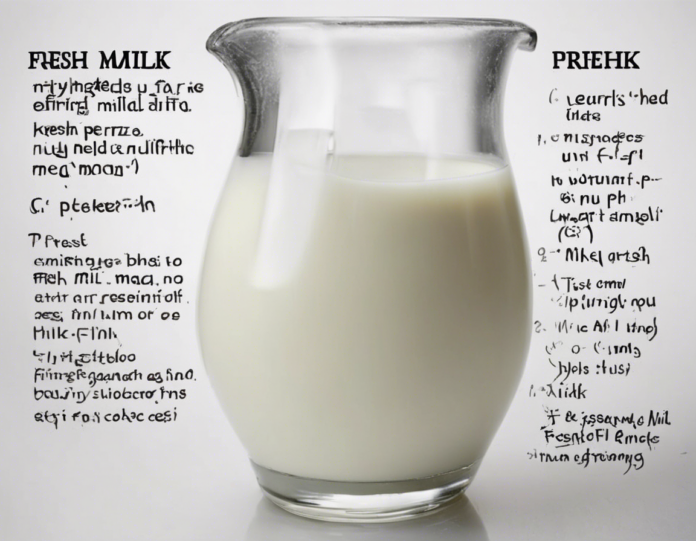Fresh milk has been a staple in many households for generations, enjoyed as a nutritious beverage or used in cooking and baking. Have you ever wondered about the pH level of fresh milk? The pH scale is a measure of acidity and alkalinity, ranging from 0 (highly acidic) to 14 (highly alkaline), with 7 considered neutral. The pH level of fresh milk typically falls around 6, making it slightly acidic. In this article, we will delve deeper into the significance of the pH level of fresh milk, its implications for health and preservation, and other related aspects of this dairy product.
Understanding the pH Level of Fresh Milk
- Acidic Nature: The slightly acidic nature of fresh milk can be attributed to the presence of lactic acid, which is produced by lactic acid bacteria during the fermentation process.
- Role of pH: The pH level of fresh milk plays a crucial role in determining its taste, texture, and shelf life. The ideal pH range for milk is around 6.6 to 6.8, which provides a balance of flavor and stability.
Importance of pH Level in Milk Quality
- Flavor: The pH level influences the flavor of fresh milk, with variations impacting its taste profile. Changes in pH can result in a sour or off-flavor taste.
- Texture: The pH level also affects the texture of fresh milk, influencing its consistency and mouthfeel.
- Shelf Life: Monitoring the pH level is essential for ensuring the safety and quality of fresh milk. An increase in acidity can lead to spoilage, affecting the shelf life of the product.
Factors Influencing pH Level in Fresh Milk
- Feed: The diet of cows can impact the pH level of fresh milk, as certain foods can alter the acidity of the milk.
- Processing: The pasteurization and homogenization processes can affect the pH level of fresh milk, with heat treatment potentially altering the acidity.
- Storage: Improper storage conditions, such as exposure to light and fluctuating temperatures, can lead to changes in the pH level of fresh milk.
Benefits of Consuming Fresh Milk with a pH Level of 6
Consuming fresh milk with a pH level of 6 offers a range of nutritional benefits:
- Calcium: Fresh milk is a rich source of calcium, essential for bone health and overall well-being.
- Protein: Milk contains protein, which is necessary for muscle growth and repair.
- Vitamins: Fresh milk is a source of vitamins such as vitamin D and B vitamins, crucial for various bodily functions.
- Hydration: Milk helps hydrate the body and provides a source of essential fluids.
The pH Level of Different Types of Milk
Different types of milk may have varying pH levels based on their composition and processing methods:
- Whole Milk: Whole milk typically has a pH level in the range of 6.5 to 6.7.
- Skim Milk: Skim milk tends to have a slightly higher pH level, often around 6.7 to 6.8, due to differences in fat content.
- Raw Milk: Raw milk may have a pH level that varies based on factors such as breed, diet, and environment of the cow.
FAQs (Frequently Asked Questions)
1. What does a pH level of 6 indicate in fresh milk?
A pH level of 6 in fresh milk indicates that it is slightly acidic, which is normal for dairy products.
2. How does the pH level affect the taste of fresh milk?
Changes in the pH level can impact the flavor of fresh milk, potentially resulting in a sour taste if the acidity increases.
3. Why is it important to monitor the pH level of fresh milk?
Monitoring the pH level of fresh milk is essential for ensuring its quality, safety, and shelf life, as variations can lead to spoilage.
4. Can the pH level of fresh milk be altered by additives?
Certain additives or contaminants can influence the pH level of fresh milk, highlighting the importance of quality control measures.
5. Is a pH level of 6 healthy for consumption?
A pH level of 6 in fresh milk is considered safe for consumption and is in line with the typical acidity of dairy products.
6. Does the pH level of fresh milk vary between brands?
While the overall pH level of fresh milk remains relatively consistent, slight variations may occur between different brands based on factors like processing methods and quality standards.
7. How can consumers test the pH level of fresh milk at home?
Consumers can use pH strips or meters to test the pH level of fresh milk at home, ensuring it falls within the acceptable range for consumption.
8. Can the pH level of fresh milk be adjusted for specific purposes, such as cooking?
Recipes may call for adjustments to the pH level of fresh milk by incorporating acidic or alkaline ingredients to achieve desired outcomes in cooking and baking.
9. What role does the pH level of fresh milk play in the dairy industry?
In the dairy industry, monitoring the pH level of fresh milk is crucial for quality control, product development, and ensuring compliance with regulatory standards.
10. Are there any health risks associated with consuming fresh milk with a pH level of 6?
As long as fresh milk is handled and stored properly, consuming it with a pH level of 6 poses no significant health risks and can be part of a balanced diet.
In conclusion, the pH level of fresh milk at 6 signifies its slightly acidic nature, with implications for taste, texture, and shelf life. Understanding the importance of pH in milk quality and consumption can help consumers appreciate this versatile and nutritious dairy product. By recognizing the factors that influence the pH level of fresh milk and its benefits, individuals can make informed choices about incorporating this beverage into their daily diet.
